Narrations and timings can enhance a web-based or self-running slide show. If you have a sound card, microphone, and speakers, and (optionally) a webcam, you can record your PowerPoint presentation and capture narrations, slide timings, and ink gestures.
After you have made the recording, it's like any other presentation that can be played for you or your audience in Slide Show—or you can save the presentation as a video file.
-
Turn on the Recording tab of the ribbon: On the File tab of the ribbon, click Options. In the Optionsdialog box, click the Customize Ribbon tab on the left. Then, in the right-hand box that lists the available ribbon tabs, select the Recording check box. Click OK.
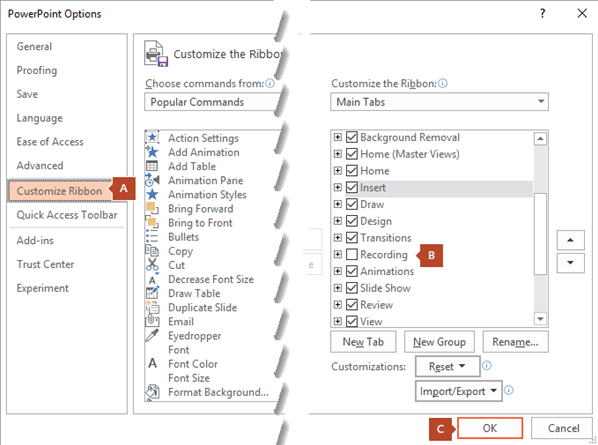
-
To get ready to record, select Record Slide Show on either the Recording tab or the Slide Show tab of the ribbon.
-
Clicking the upper half of the button starts you on the current slide.
-
Clicking the lower half of the button gives you the option to start from the beginning or from the current slide.
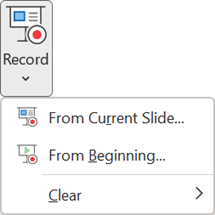
(The Clear command deletes narrations or timings, so be careful when you use it. Clear is grayed out unless you have previously recorded some slides.)
-
-
The slide show opens in the Recording window (which looks similar to Presenter view), with buttons at the top left for starting, pausing, and stopping the recording. Click the round, red button (or press R on your keyboard) when you are ready to start the recording. A three-second countdown ensues, then the recording begins.
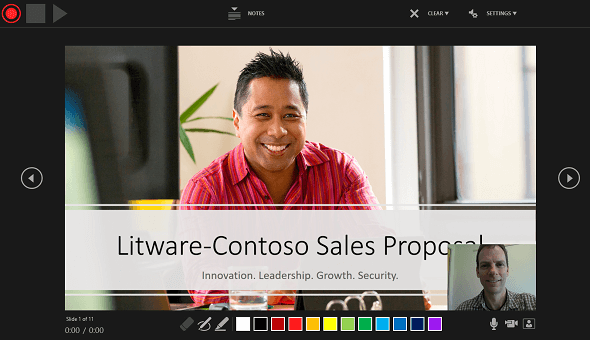
-
The current slide is shown in the main pane of the Recording window.
-
You can stop the recording any time by pressing Alt+S on your keyboard.
-
Navigation arrows on either side of the current slide allow you to move to the previous and next slides.
-
PowerPoint for Office 365 automatically records the time you spend on each slide, including any animation steps that occur, and the use of any triggers on each slide.
-
You can record audio or video narration as you run through your presentation. The buttons at the lower-right corner of the window allow you to toggle on or off the microphone, camera, and camera preview:

If you use the pen, highlighter, or eraser, PowerPoint records those actions for playback also.

If you re-record your narration (including audio and ink), PowerPoint erases your previously recorded narration (including audio and ink) before you start recording again on the same slide.
You can also re-record by going to Slide Show > Record Slide Show.
-
-
You can pick a pointer tool (pen, eraser, or highlighter) from the array of tools just below the current slide. There are also color selection boxes for changing the color of the ink. (Eraser is grayed out unless you have previously added ink to some slides.)
-
To end your recording, select the square Stop button (or press S on your keyboard).
When you finish recording your narration, a small picture appears in the lower-right corner of the recorded slides. The picture is an audio icon, or, if the web camera was on during the recording, a still image from the webcam.
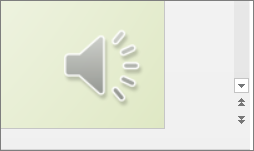
The recorded slide show timing is automatically saved. (In Slide Sorter view, the timings are listed beneath each slide.)
In this process, what you record is embedded in each slide, and the recording can be played back in Slide Show. A video file is not created by this recording process. However, if you need one, you can save your presentation as a video with a few extra steps.
Preview the recorded slide show
On the Slide Show tab, click From Beginning or From Current Slide.
During playback, your animations, inking actions, audio and video will play in sync.

Preview the recorded sound
In the Recording window, the triangular Play button near the top left corner lets you preview the recording of the slide that currently has the focus in that window.

In Normal view, click the sound icon or picture in the lower-right corner of the slide, and then click Play. (When you preview individual audio in this way, you won't see recorded animation or inking.)
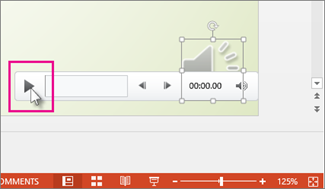
You can pause playback while previewing the audio.
Set the slide timings manually
PowerPoint for Office 365 automatically records your slide timings when you add narrations, or you can manually set the slide timings to accompany your narrations.
-
In Normal view, click the slide that you want to set the timing for.
-
On the Transitions tab, in the Timing group, under Advance Slide, select the After check box, and then enter the number of seconds that you want the slide to appear on the screen. Repeat the process for each slide that you want to set the timing for.
If you want the next slide to appear either when you click the mouse or automatically after the number of seconds that you enter — whichever comes first — select both the On Mouse Click and the After check boxes.
You can use manual slide timings to the trim the end of a recorded slide segment. For example, if the end of a slide segment concludes with two seconds of unnecessary audio, simply set the timing for advancing to the next slide so that it happens before the unnecessary audio. That way you don't have to re-record the audio for that slide.
Delete timings or narration
The Clear command is for deleting timings or narration from your recording that you don't want or that you want to replace.
In the Recording window, the Clear command in the top margin of the window allows you to:
-
Clear recordings on the current slide
-
Clear recordings on all slides
In Normal view, there are four different Clear commands that allow you to:
-
Delete the timings on the currently selected slide
-
Delete the timings on all slides at once
-
Delete the narration on the currently selected slide
-
Delete the narration on all slides at once
-
If you do not want to delete all the timings or narration in your presentation, open a specific slide that has a timing or narration that you do want to delete.
-
On the Recording tab of the PowerPoint for Office 365 ribbon, on the Record Slide Show button, click the down arrow, point to Clear, and then choose the appropriate Clear command for your situation.
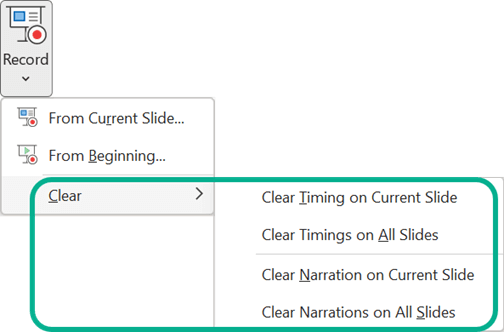
Turn off timings or turn off narrations, and ink
After you've recorded your PowerPoint for Office 365 presentation, any timings, gestures, and audio you performed are saved on the individual slides. But you can turn them all off if you want to view the slide show without them:
-
To turn off recorded slide timings: On the Slide Show tab, clear the Use Timings box.
-
To turn off recorded narrations and ink: On the Slide Show tab, clear the Play Narrations box.
Publish the recording to share it with others
Once you've edited the recording to your satisfaction, you can make it available to others by publishing to Microsoft Stream.
-
With the presentation open, on the Recording tab, select Publish to Stream.
-
Type a title and a description for the video.
-
Set other options, including whether you want others in your organization to have permission to see the video:

-
Select the Publish button.
The upload process can take several minutes, depending on the length of the video. A status bar at the bottom of the PowerPoint window tracks the progress, and PowerPoint shows a message when the upload is finished:
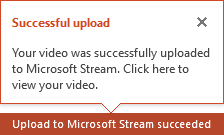
-
Click the message to go directly to the video playback page on Microsoft Stream.
Recording tips
-
Recordings are added to the presentation on a per-slide basis, so if you want to change a recording, you only have to re-record the affected slide or slides. Also, you can rearrange the order of slides after recording without having to re-record anything. This also means it's easy to pause for a break while recording a presentation.
-
PowerPoint doesn't record audio or video during transitions between slides, so don't speak while advancing the slide. Also, include a brief buffer of silence at the beginning and the end of each slide to make the transitions smooth and ensure that you don't cut off audible narration while transitioning from one slide to the next.
-
You can't record narration in PowerPoint Online. Use a desktop version of PowerPoint to record your narration.
-
You can adjust and edit the size of video and ink in edit view.
-
If it's possible that your audience may use PowerPoint Online to experience the recording, use the transitions that are supported by PowerPoint Online (Cut, Fade, Push, Wipe, Split, Random Bars, Shape, Morph).
-
Presentation recording works best with touch-screen PCs that have a web camera.
-
Use video preview to make sure everything is set up correctly before recording.
-
For slides that you want to record gestures (such as ink) on, make multiple copies of the slide so that you can easily record multiple takes. Then delete the extraneous slides when you're done.
-
Record a few seconds of silence by turning off audio and video to advance after a set time.
-
For higher quality, use an external web cam and/or microphone.
Built-in cameras and microphones are suitable for most tasks. But if you want more professional-looking video, consider using an external web cam, if you're able. If you're using PowerPoint on a tablet or laptop and you're inking with a stylus, an external camera and microphone allows you to minimize stylus noise.
-
As soon as you finish your first slide recording, play it back.
Before you get too far down the road of recording your presentation, make sure your audio and video sound and look the way you expect.
Recordings are added to the presentation on a per-slide basis, so if you want to change a recording, you only have to re-record the affected slide or slides. Also, you can rearrange the order of slides after recording without having to re-record anything. This also means it's easy to pause for a break while recording a presentation.
PowerPoint doesn't record audio or video during transitions between slides, so don't speak while advancing the slide. Also, include a brief buffer of silence at the beginning and the end of each slide to make the transitions smooth and ensure that you don't cut off audible narration while transitioning from one slide to the next.
You can't record narration in PowerPoint Online. Use a desktop version of PowerPoint to record your narration.
You can adjust and edit the size of video and ink in edit view.
If it's possible that your audience may use PowerPoint Online to experience the recording, use the transitions that are supported by PowerPoint Online (Cut, Fade, Push, Wipe, Split, Random Bars, Shape, Morph).
Presentation recording works best with touch-screen PCs that have a web camera.
Use video preview to make sure everything is set up correctly before recording.
For slides that you want to record gestures (such as ink) on, make multiple copies of the slide so that you can easily record multiple takes. Then delete the extraneous slides when you're done.
Record a few seconds of silence by turning off audio and video to advance after a set time.
For higher quality, use an external web cam and/or microphone.
Built-in cameras and microphones are suitable for most tasks. But if you want more professional-looking video, consider using an external web cam, if you're able. If you're using PowerPoint on a tablet or laptop and you're inking with a stylus, an external camera and microphone allows you to minimize stylus noise.
As soon as you finish your first slide recording, play it back.
Before you get too far down the road of recording your presentation, make sure your audio and video sound and look the way you expect.
Source: Microsoft
